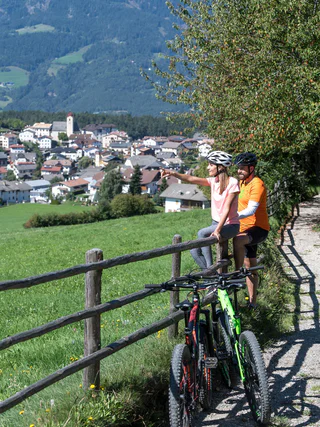
Almtrail
Resia/Reschen, Graun im Vinschgau/Curon Venosta, Vinschgau/Val Venosta
Čistý adrenalin před působivou horskou scenérií: MTB výlety v Jižním Tyrolsku nabízejí zábavu pro každého bikera. Na cestu, vyrazte! Jako freerider prozkoumejte údolí ve Vinschgau, objevte Alpe di Siusi, největší alpskou louku v Evropě, na dvou kolech nebo pocítíte vítr při plynulém sjezdu z Kronplatzu. Jihotyrolské MTB túry jsou zárukou zábavy z jízdy a zážitků z přírody.

Resia/Reschen, Graun im Vinschgau/Curon Venosta, Vinschgau/Val Venosta

1/3
Albion/Albions, Lajen/Laion
medium
Obtížnost
463 m
nadmořská výška
5.1 Km
vzdálenost

Antermoia/Untermoj, San Martin /San Martino, Dolomites Region Kronplatz/Plan de Corones

Kurtatsch/Cortaccia s.S.d.V., Kurtatsch an der Weinstraße/Cortaccia sulla Strada del Vino, Alto Adige Wine Road

S.Valentino /St. Valentin, Graun im Vinschgau/Curon Venosta, Vinschgau/Val Venosta

S. Pietro/St. Peter - Funes/Villnöss, Villnöss/Funes, Dolomites Region Villnösstal
medium
Obtížnost
410 m
nadmořská výška
10.4 Km
vzdálenost

Riobianco/Weissenbach - Valle Aurina/Ahrntal, Ahrntal/Valle Aurina, Ahrntal/Valle Aurina

Caldaro Paese/Kaltern Dorf, Kaltern an der Weinstraße/Caldaro sulla Strada del Vino, Alto Adige Wine Road

Plose/Plose, Brixen/Bressanone, Brixen/Bressanone and environs
medium
Obtížnost
412 m
nadmořská výška
4.0 Km
vzdálenost

1/2
Riscone/Reischach, Al Plan/San Vigilio, Dolomites Region Kronplatz/Plan de Corones
medium
Obtížnost
0 m
nadmořská výška
4.9 Km
vzdálenost

1/2
Auer/Ora, Alto Adige Wine Road

Naturno/Naturns, Naturns/Naturno, Meran/Merano and environs

Gossensaß/Colle Isarco, Brenner/Brennero, Sterzing/Vipiteno and environs

Plose/Plose, Brixen/Bressanone, Brixen/Bressanone and environs

Montefontana/Tomberg, Kastelbell-Tschars/Castelbello-Ciardes, Vinschgau/Val Venosta

Stelvio/Stilfs, Stilfs/Stelvio, Vinschgau/Val Venosta

1/10
Ora/Auer, Auer/Ora, Alto Adige Wine Road
medium
Obtížnost
1123 m
nadmořská výška
27.1 Km
vzdálenost

1/2
Valdaora di Mezzo/Mitterolang, Olang/Valdaora, Dolomites Region Kronplatz/Plan de Corones

S. Martino al Monte/St. Martin - Laces/Latsch, Latsch/Laces, Vinschgau/Val Venosta

1/3
Karthaus/Certosa, Schnals/Senales, Vinschgau/Val Venosta

1/4
San Lugano/San Lugano, Truden/Trodena

1/3
San Vigilio, Al Plan/San Vigilio, Dolomites Region Kronplatz/Plan de Corones

1/2
S.Antonio/St.Anton, Völs am Schlern/Fiè allo Sciliar, Dolomites Region Seiser Alm

Resia/Reschen, Graun im Vinschgau/Curon Venosta, Vinschgau/Val Venosta

Ciardes/Tschars, Kastelbell-Tschars/Castelbello-Ciardes, Vinschgau/Val Venosta

S. Candido/Innichen, Innichen/San Candido, Dolomites Region 3 Zinnen

1/2
Pietrarossa/Rotwand, Ritten/Renon, Bolzano/Bozen and environs
easy
Obtížnost
147 m
nadmořská výška
2.8 Km
vzdálenost

S. Osvaldo/St. Oswald - Castelrotto/Kastelruth, Kastelruth/Castelrotto, Dolomites Region Seiser Alm

1/2
Maranza/Meransen, Mühlbach/Rio di Pusteria, Brixen/Bressanone and environs
medium
Obtížnost
282 m
nadmořská výška
10.3 Km
vzdálenost

Casere/Kasern, Prettau/Predoi, Ahrntal/Valle Aurina